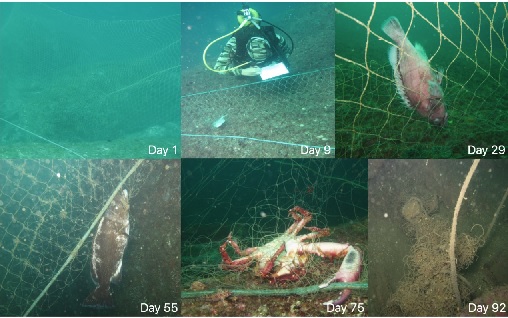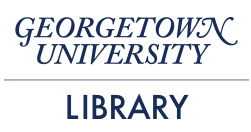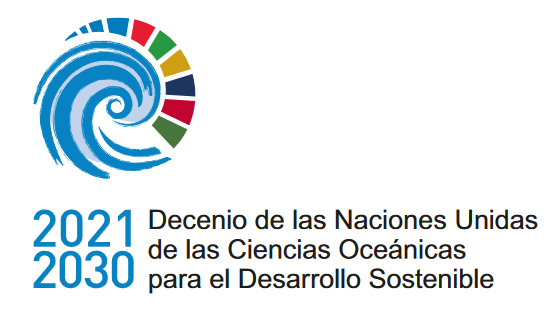Estudio experimental sobre pesca fantasma en arrecifes costeros rocosos del sur de Brasil
DOI:
https://doi.org/10.47193/mafis.3532022010904Palabras clave:
Redes de enmalle abandonadas, enmallado, basura marinaResumen
Se realizó un experimento de pesca fantasma utilizando redes de enmalle en un arrecife rocoso frente al estado de Santa Catarina, en el sur de Brasil. Los buzos monitorearon los cambios en la estructura de las redes y las capturas durante 92 días. Se observaron ciento veintiséis animales enmallados, entre especies de pesca objetivo y no objetivo: 13 teleósteos (N = 52; 43%) y cuatro crustáceos (N = 74; 57%). El cangrejo Menippe nodifrons fue la especie más frecuentemente enmallada (N = 36; 28%). Las tasas de enmalle disminuyeron con el tiempo siguiendo un modelo logarítmico para peces y crustáceos, y un modelo exponencial para ambos taxones combinados, atribuidos a la degradación y enredo de las redes y bioincrustaciones. El área de la red disminuyó linealmente con el tiempo, la cual colapsó después de 92 días. Este estudio proporciona la primera evaluación experimental de los impactos de la pesca fantasma causada por redes de enmalle en los arrecifes rocosos de Brasil.
Descargas
Métricas
Citas
Adelir-Alves J, Pinheiro PC. 2011. Peixes recifais das ilhas costeiras do Balneário Barra do Sul - Santa Catarina - Brasil. Rev CEPSUL, Biodiversidade Conservação Marinha. 2: 10-21.
Adelir-Alves J, Rocha GRA, Souza TF, Pinheiro PC, Freire KMF. 2016. Abandoned, lost, or otherwise discarded fishing gears in rocky reefs of Southern Brazil. Braz J Oceanogr. 64 (4): 427-434. DOI: https://doi.org/10.1590/S1679-87592016124806404
Akiyama S, Saito E, Watanabe T. 2007. Relationship between soak time and number of enmeshed animals in experimentally lost gill nets. Fish Sci. 73: 881-888. DOI: https://doi.org/10.1111/j.1444-2906.2007.01409.x
Andrades R, Pegado T, Godoy BS, Reis-Filho JA, Nunes JLS, Grillo AC, Machado RC, Santos RG, Dalcin RH, Freitas MO, et al. 2020. Anthropogenic litter on Brazilian beaches: baseline, trends, and recommendations for future approaches. Mar Pollut Bull. 151: 110842. DOI: https://doi.org/10.1016/j.marpolbul.2019.110842
Ayaz A, Acarli D, Altinagac U, Ozekinci U, Kara A, Ozen O. 2006. Ghost fishing by monofilament and multifilament gillnets in Izmir Bay, Turkey. Fish Res. 79: 267-271. DOI: https://doi.org/10.1016/j.fishres.2006.03.029
Azevedo-Santos VM, Hughes RM, Pelicice FM. 2022. Ghost nets: a poorly known threat to Brazilian freshwater biodiversity. An Acad Bras Cienc. 94 (1): e20201189. DOI: https://doi.org/10.1590/0001-3765202120201189
Azevedo-Santos VM, Marques LM, Teixeira CR, Giarrizzo T, Barreto R, Rodrigues-Filho JL. 2021. Digital media reveal negative impacts of ghost nets on Brazilian marine biodiversity. Mar Pollut Bull. 172: 112821. DOI: https://doi.org/10.1016/j.marpolbul.2021.112821
Baeta F, Costa MJ, Cabral H. 2009. Trammel nets’ ghost fishing off the Portuguese central coast. Fish Res. 98: 33-39. DOI: https://doi.org/10.1016/j.fishres.2009.03.009
Beneli TM, Pereira PHC, Nunes JACC, Barros F. 2020. Ghost fishing impacts on hydrocorals and associated reef fish assemblages. Mar Environ Res. 161: 105129. DOI: https://doi.org/10.1016/j.marenvres.2020.105129
Brown J, Macfadyen G. 2007. Ghost fishing in European waters: impacts and management responses. Mar Policy. 31: 488-504. DOI: https://doi.org/10.1016/j.marpol.2006.10.007
Carvalho JLB, Schettini CAF, Ribas TM. 1998. Estrutura termohalina do litoral centro-norte catarinense. Notas Tec FACIMAR. 2: 181-197.
Carvalho-Filho A. 1999. Peixes da costa brasileira. São Paulo: Melro. 320 p.
Chaves PT, Robert MC. 2009. Extravio de petrechos e condições para ocorrência de pesca fantasma no litoral de Santa Catarina e sul do Paraná. Bol Inst Pesca. 35 (3): 513-519.
Dantas DV, Barletta M, Costa MF. 2012. The seasonal and spatial patterns of ingestion of polyfilament nylon fragments by estuarine drums (Sciaenidae). Environ Sci Pollut R. 19: 600-606. DOI: https://doi.org/10.1007/s11356-011-0579-0
Dayton PK, Thrush SF, Agardy MT, Hofman RJ. 1995. Environmental effects of marine fishing. Aquat Conserv. 5: 205-232.
Donohue MJ, Boland RC, Sramek CM, Antonelis GA. 2001. Derelict fishing gear in the Northwestern Hawaiian Islands: diving surveys and debris removal confirms threat to coral reef ecosystems. Mar Pollut Bull. 42 (12): 1301-1312. DOI: https://doi.org/10.1016/S0025-326X(01)00139-4
Erzini K, Monteiro CC, Ribeiro J, Santos MN, Gaspar M, Monteiro P, Borges TC. 1997. An experimental study of gill net and trammel net “ghost-fishing” off the Algarve (southern Portugal). Mar Ecol Progr Ser. 158: 257-265. DOI: https://doi.org/10.3354/meps158257
[FAO] Food and Agriculture Organization of the United Nations. 1995. Code of conduct for responsible fisheries. Food and Agriculture Organization of the United Nations. Rome: FAO. 14 p.
[FAO] Food and Agriculture Organization of the United Nations. 2020. The state of world fisheries and aquaculture 2020. Sustainability in action. Rome: FAO. 206 p. DOI: https://doi.org/10.4060/ca9229en
Faraway JJ. 2002. Practical regression and Anova using R. 212 p. http://cran.r-project.org/doc/contrib/Faraway-PRA.pdf.
Figueiredo JL, Menezes NA. 1978. Manual dos peixes marinhos do Sudeste do Brasil. II. Teleostei (1). São Paulo: Museu de Zoologia, Universidade de São Paulo. 110 p.
Figueiredo JL, Menezes NA. 1980. Manual dos peixes marinhos do Sudeste do Brasil. III. Teleostei (2). São Paulo: Museu de Zoologia, Universidade de São Paulo. 90 p.
Figueiredo JL, Menezes NA. 2000. Manual dos peixes marinhos do Sudeste do Brasil. VI. Teleostei (5). São Paulo: Museu de Zoologia, Universidade de São Paulo. 116 p.
Floeter SR, Gasparini JL. 2000. The southwestern Atlantic reef fish fauna: composition and zoogeographic patterns. J Fish Biol. 56: 1099-1114. DOI: https://doi.org/10.1111/j.1095-8649.2000.tb02126.x
Fonteles-Filho AD. 1999. Síntese sobre distribuição, abundância, potencial pesqueiro e biologia lagosta-vermelha Panulirus argus (Latreille) e a lagosta-verde Panulirus laevicauda (Latreille) do Nordeste do Brasil. Avaliação do Potencial Sustentável de Recursos Vivos na Zona Econômica Exclusiva MMA - REVIZEE. Análise/Refinamento dos Dados Pretéritos Sobre Prospecção Pesqueira.
Froese R, Pauly D, editores. 2020. FishBase. [accessed 2021 January 4]. http://www.fishbase.org.
Gilardi KVK, Carlson-Bremer D, June JA, Antonelis K, Broadhurst G, Cowan T. 2010. Marine species mortality in derelict fishing nets in Puget Sound, WA, and the cost/benefits of derelict net removal. Mar Pollut Bull. 60: 376-382. DOI: https://doi.org/10.1016/j.marpolbul.2009.10.016
Gilman E. 2015. Status of international monitoring and management of abandoned, lost, and discarded fishing gear and ghost fishing. Mar Policy. 60: 225-239. DOI: https://doi.org/10.1016/j.marpol.2015.06.016
Gilman E, Chopin F, Suuronen P, Kuemlangan B. 2016. Abandoned, lost, and discarded gillnets and trammel nets: methods to estimate ghost fishing mortality, and the status of regional monitoring and management. FAO Fish Aquacult Tech Pap. 600. 80 p.
Gilman E, Musyl M, Suuronen P, Chaloupka M, Gorgin S, Wilson J, Kuczenski B. 2021. Highest risk abandoned, lost, and discarded fishing gear. Sci Rep-UK. 11: 7195. DOI: https://doi.org/10.1038/s41598-021-86123-3
Gilman E, Passfield K, Nakamura K. 2012. Performance assessment of bycatch and discards. Governance by Regional Fisheries Management Organizations. IUCN, Switzerland, 484 p.
Goldberg ED. 1995. Emerging problems in the coastal zone for the twenty-first century. Mar Pollut Bull. 31: 152-158. DOI: https://doi.org/10.1016/0025-326X(95)00102-S
Grillo AC, Mello TJ. 2021. Marine debris in the Fernando de Noronha Archipelago, a remote oceanic marine protected area in tropical SW Atlantic. Mar Pollut Bull. 164: 112021. DOI: https://doi.org/10.1016/j.marpolbul.2021.112021
Heine JN. 1999. Scientific diving techniques: a practical guide for the research diver. Best Publishing Company. p. 225.
Iriarte V, Marmontel M. 2013. River dolphin (Inia geoffrensis, Sotalia fluviatilis) mortality events attributed to artisanal fisheries in the Western Brazilian Amazon. Aquat Mamm. 39 (2): 116-124. DOI: https://doi.org/10.1578/AM.39.2.2013.116
Kaiser MJ, Bullimore B, Newman P, Lock K, Gilbert S. 1996. Catches in ‘ghost fishing’ set nets. Mar Ecol Progr Ser. 145: 11-16. DOI: https://doi.org/10.3354/meps145011
Kura Y, Revenga C, Hoshino E, Mock G. 2004. Why care about fish? In: Kura Y, Revenga C, Hoshino E, Mock G, editors. Fishing for answers, making sense of global fish crisis. Washington: World Resources Institute. p. 1-6.
Link J, Segal B, Casarini LM. 2019. Abandoned, lost, or otherwise discarded fishing gear in Brazil: a review. Perspect Ecol Conserv. 17: 1-8. DOI: https://doi.org/10.1016/j.pecon.2018.12.003
Macfadyen G, Huntington T, Cappell R. 2009. Abandoned, lost, or otherwise discarded fishing gear. FAO Fish Aquacult Tech Paper. 523. 115 p.
Machado AA, Fillmann G. 2010. Estudo da contaminação por resíduos sólidos na ilha do Arvoredo, Reserva Biológica Marinha do Arvoredo - SC, Brasil. Rev Gestão Costeira Integrada. 10: 381-393. DOI: https://doi.org/10.5894/rgci215
Mai ACG, Rosa IML. 2009. Aspectos ecológicos do cavalo-marinho Hippocampus reidi no estuário Camurupim/Cardoso, Piauí, Brasil, fornecendo subsídios para a criação de uma Área de Proteção Integral. Biota Neotrop. 9: 85-91. DOI: https://doi.org/10.1590/S1676-06032009000300007
Mascarenhas R, Batista CP, Moura IF, Caldas AR, Costa-Neto JMC, Vasconcelos MQ, Rosa SS, Barros TVS. 2008. Lixo marinho em área de reprodução de tartarugas marinhas no Estado da Paraíba (Nordeste do Brasil). Rev Gestão Costeira Integrada. 8: 221-231. DOI: https://doi.org/10.5894/rgci138
Matsuoka T, Nakashima T, Nagasawa N. 2005. A review of ghost fishing: scientific approaches to evaluation and solutions. Fisheries Sci. 71: 691-702. DOI: https://doi.org/10.1111/j.1444-2906.2005.01019.x
McElwee K, Donohue MJ, Courtney CA, Morishige C, Rivera-Vicente A. 2011. A strategy for detecting derelict fishing gear at sea. Mar Pollut Bull. 65: 7-15. DOI: https://doi.org/10.1016/j.marpolbul.2011.09.006
Melo GAS. 1996. Manual de identificação dos Brachyura (caranguejos e siris) do litoral brasileiro. São Paulo: Editora Plêiade. 603 p.
Menezes NA, Buckup PA, Figueiredo JL, Moura RL. 2003. Catálogo das espécies de peixes marinhos do Brasil. São Paulo: Museu de Zoologia, Universidade de São Paulo. 160 p.
Menezes NA, Figueiredo JL. 1980. Manual de peixes marinhos do Sudeste do Brasil. IV. Teleostei (3). São Paulo: Museu de Zoologia, Universidade de São Paulo. 96 p.
Menezes NA, Figueiredo JL. 1985. Manual de peixes marinhos do Sudeste do Brasil. V. Teleostei (4). São Paulo: Museu de Zoologia, Universidade de São Paulo. 105 p.
[MMA] Ministério do Meio Ambiente. 2016. Livro vermelho da fauna brasileira ameaçada de extinção. Brasilia: MMA. 142 p. https://www.icmbio.gov.br/ran/images/stories/Noticias/sumario_executivo_livro_vermelho_ed_2016.pdf.
Mordecai G, Tyler PA, Masson DG, Huvenne VAI. 2011. Litter in submarine canyons off the west coast of Portugal. Deep-Sea Res (II Top Stud Oceanogr). 58: 2489-2496. DOI: https://doi.org/10.1016/j.dsr2.2011.08.009
Morishige C, McElwee K. 2012. At-sea detection of derelict fishing gear in the North Pacific: an overview. Mar Pollut Bull. 65: 1-6. DOI: https://doi.org/10.1016/j.marpolbul.2011.05.017
[NOAA] National Oceanic and Atmospheric Administration Marine Debris Program. 2014. Report on the entanglement of marine species in marine debris with an emphasis on species in the United States. Silver Spring, MD. 28 p.
Oshiro LMY. 1999. Aspectos reprodutivos do caranguejo guaia, Menippe nodifrons Stimpson (Crustacea, Decapoda, Xanthidae) da Baía de Sepetiba, Rio de Janeiro, Brasil. Rev Bras Zool. 16: 827-834. DOI: https://doi.org/10.1590/S0101-81751999000300019
Pereira MD, Schettini CAF, Omachi CY. 2009. Caracterização de feições oceanográficas na plataforma de Santa Catarina através de imagens orbitais. Braz J Geophysics. 27: 81-93. DOI: https://doi.org/10.1590/S0102-261X2009000100007
Pinheiro LM, Lupchinski-Junior E, Denuncio P, Machado R. 2021. Fishing plastics: a high occurrence of marine litter in surf-zone trammel nets of Southern Brazil. Mar Pollut Bull. 173: 112946. DOI: https://doi.org/10.1016/j.marpolbul.2021.112946
Pollard DA, Afonso P, Bertoncini AA, Fennessy S, Francour P, Barreiros J. 2018. IUCN Grouper and Wrasse Specialist Group. Epinephelus marginatus. The IUCN Red List of Threatened Species. DOI: https://doi.org/10.2305/IUCN.UK.2018-2.RLTS.T7859A100467602.en
Pollock NW, Godfrey JM. 2007. Diving for Science. Proceedings of the American Academy of Underwater Sciences. University of Miami.
Possatto FE, Barletta M, Costa MF, Ivar do Sul JA, Dantas DV. 2011. Plastic debris ingestion by marine catfish: an unexpected fisheries impact. Mar Pollut Bull. 62: 1098-1102. DOI: https://doi.org/10.1016/j.marpolbul.2011.01.036
Queirolo D, Gaete E. 2014. Experimental study of ghost fishing by gillnets in Laguna Verde Valparaíso, Chile. Lat Am J Aquat Res. 42 (5): 1189-1193. DOI: https://doi.org/10.3856/vol42-issue5-fulltext-22
Revill AS, Dunlin G. 2003. The fishing capacity of gillnets lost on wrecks and on open ground in UK coastal waters. Fish Res. 64: 107-113. DOI: https://doi.org/10.1016/S0165-7836(03)00209-1
Rieger PJ, Giraldi JLB. 2001. Mithrax hispidus (Herbst) e Mithrax tortugae (Rathbun) novos registros de Brachyura (Decapoda, Majidae) para a litoral de Santa Catarina, Brasil. Rev Bras Zool. 18: 653-654. DOI: https://doi.org/10.1590/S0101- 81752001000200034
Saldanha HJ, Sancho G, Santos MN, Puente E, Gaspar MB, Bilbao A, Monteiro CC, Gomez E, Arregi L. 2003. The use of biofouling for ageing lost nets: a case study. Fish Res. 64: 141-150. DOI: https://doi.org/10.1016/S0165-7836(03)00213-3
Santos AJB, Bellini C, Bortolon LF, Coluchi R. 2012. Ghost nets haunt the Olive Ridley Turtle (Lepidochelys olivacea) near the Brazilian islands of Fernando de Noronha and Atol das Rocas. Herpetol Rev. 43 (2): 245-246.
Shomura RS, Yoshida HO. 1985. Proceedings of the Workshop on the Fate and Impact of Marine Debris, 27-29 November 1984, Honolulu, Hawaii. Washington: Sea grant cooperative report 85-04. NOAA-TM-NMFS-SWFC. 54. 580 p.
Smolowitz RJ. 1978. Trap design and ghost fishing: discussion. Mar Fish Rev. 40: 59-67.
Stelfox M, Hudgins J, Sweet M. 2016. A review of ghost gear entanglement amongst marine mammals, reptiles, and elasmobranchs. Mar Pollut Bull. 111: 6-17. DOI: https://doi.org/10.1016/j.marpolbul.2016.06.034
Tschernij V, Larsson P-O. 2003. Ghost fishing by lost cod gill nets in the Baltic Sea. Fish Res. 64: 151-162. DOI: https://doi.org/10.1016/S0165-7836(03)00214-5
Vieira BP, Dias D, Hanazaki N. 2011. Homogeneidade de encalhe de resíduos sólidos em um manguezal da Ilha de Santa Catarina, Brasil. Rev Gestão Costeira Integrada. 11: 21-30. DOI: https://doi.org/10.5894/rgci188
Watters DL, Yoklavich MM, Love MS, Schroeder DM. 2010. Assessing marine debris in deep seafloor habitats off California. Mar Pollut Bull. 60: 131-138. DOI: https://doi.org/10.1016/j.marpolbul.2009.08.019
Zar JH. 2010. Biostatistical analysis. 5th ed. Upper Saddle River: Prentice Hall. 944 p.

Descargas
Publicado
Cómo citar
Número
Sección
Licencia
Derechos de autor 2022 Johnatas Adelir-Alves, Gecely Rodrigues Alves Rocha, Kátia de Meirelles Felizola Freire, Pedro Carlos Pinheiro, Luis Felipe de Almeida Duarte

Esta obra está bajo una licencia internacional Creative Commons Atribución-NoComercial-CompartirIgual 4.0.
Los autores de los artículos publicados en Marine and Fishery Sciences conservan los derechos de autor de sus artículos, a excepción de las imágenes de terceros y otros materiales añadidos por Marine and Fishery Sciences, que están sujetos a los derechos de autor de sus respectivos propietarios. Por lo tanto, los autores son libres de difundir y volver a publicar sus artículos, sujeto a los requisitos de los propietarios de derechos de autor de terceros y sujeto a que la publicación original sea completamente citada. Los visitantes también pueden descargar y reenviar artículos sujetos a los requisitos de citas. La capacidad de copiar, descargar, reenviar o distribuir cualquier material siempre está sujeta a los avisos de derechos de autor que se muestran. Los avisos de copyright deben mostrarse de manera prominente y no pueden borrarse, eliminarse u ocultarse, total o parcialmente. El autoalmacenamiento en servidores y repositorios de preimpresión está permitido para todas las versiones.
Esta revista ofrece a los autores una política de acceso abierto. Los usuarios pueden leer, descargar, copiar, distribuir, imprimir, buscar o vincular los textos completos de los artículos, o usarlos para cualquier otro propósito legal dentro de la licencia Creative Commons 4.0 (BY-NC-SA), sin solicitar permiso previo del editor o del autor. Esto está de acuerdo con la definición BOAI de acceso abierto.
 https://orcid.org/0000-0002-8882-4009
https://orcid.org/0000-0002-8882-4009 https://orcid.org/0000-0003-1459-8042
https://orcid.org/0000-0003-1459-8042 https://orcid.org/0000-0002-6190-3532
https://orcid.org/0000-0002-6190-3532 https://orcid.org/0000-0002-4658-4684
https://orcid.org/0000-0002-4658-4684 https://orcid.org/0000-0001-6333-8584
https://orcid.org/0000-0001-6333-8584


























